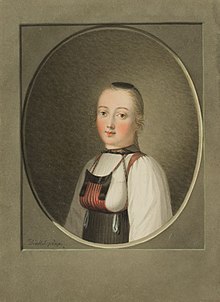Markus Dinkel
Markus Dinkel (born February 12, 1762 in Eiken ; † February 5, 1832 in Bern ) was a Swiss painter who preferred to produce watercolors and gouaches of Swiss traditional costumes .
Life
Markus Dinkel was born in 1762 in Eiken, which at that time still belonged to Upper Austria . In the 1780s he applied in Zurich to no avail for training with the landscape painter Johann Heinrich Wüest . Dinkel was more successful with Johann Kaspar Lavater , who gave him several orders. Lavater, himself portrayed several times by Dinkel, was not satisfied with Dinkel's achievements and lifestyle. Under a self-portrait by Dinkel, he noted on March 20, 1790: "So in front of the mirror there is a mixture of talent / and carelessness."
From 1793 Markus Dinkel permanently moved to Bern. He first worked as a colorist with Gabriel Lory (1763-1840). As a freelance artist, he mainly worked as a portrait painter for the local patriciate and as a costume painter for travelers on the Grand Tour , who sometimes had him portrayed in Swiss national costumes. A portrait of Joséphine de Beauharnais in Bernese peasant costume is known, which was probably made during her stay in Switzerland in 1810. A considerable part of Dinkel's work is revealing and erotic subjects.
In 1810, 1818, 1824 and 1830 Markus Dinkel took part in the Bern art and industrial exhibitions with watercolors (1810 after Raphael, de la Haye and Boucher). Together with Johann Emanuel Locher , Markus Dinkel made drawings for Johann Peter Lamy from 1820 onwards for the extraordinarily carefully designed Recueil des Portraits Suisses des 22 Cantons . After Gerold Rusch, the band came into being on the initiative of Princess Charlotte de Galles, married of Sachsen-Coburg-Saalfeld. Because of an elaborate lifestyle, spelled became impoverished. The sale of nudities was damaging to his reputation. Standing on the verge of bankruptcy , Dinkel threw himself from Bern's Untertorbrücke into the Aare on February 5, 1832 and drowned. Bankruptcy proceedings opened after his death in March.
Rescue of Niklaus von Steiger
On March 5, 1798, Markus Dinkel helped as a volunteer gunner after the Battle of Grauholz in the rescue of the ruling Bernese mayor Niklaus Friedrich von Steiger . The rescue of Steigers by Markus Dinkel and Steiger's Ordonanzkorporal Christian Dubi was engraved by Balthasar Anton Dunker in 1800 in the series of engravings: Friedrich von Steiger's Last Years . The later description by Christian Dubi around 1815 relativizes the role of Dinkel, who is said to have come across von Steiger and him only after Bern. The pictorial representations of Dunker from 1800 are based on the point of view of Markus Dinkel, in which his contribution to the rescue starts earlier and more actively.
reception
Markus Dinkel, despite his painterly qualities, his own style and a Europe-wide fame, was dismissed by contemporaries as an idiosyncratic "owl" and not included in the relevant artist directories of his time (Füssli, Meusel, Nagler). In art history he is classified among the Swiss minor masters .
Works
Dinkel's work can be found in the art museums of Aarau , Basel , Bern and Solothurn , as well as in the Fricktaler Museum in Rheinfelden. An extensive representative collection of his works on paper was acquired by the Fitzwilliam Museum in Cambridge in 1910 . The British Museum in London also has a smaller collection of works by and after Markus Dinkel.
- selection
- Johann Kaspar Lavater in his Gouache study , 1790.
- Niklaus Friedrich von Steiger , gouache, half-length portrait, 1798.
- Leda and her sister Althaia with the swan , after the painting by François Boucher .
- Josephine Beauharnais in traditional Bern costume , 1810.
- Arthur Wellesley, 1st Duke of Wellington , 1815.
- Recueil de portraits et costumes Suisses des 22 cantons accompagné d'un supplément , Johann Peter Lamy, Bern 1820–1829.
- Prince Louis Napoleon, son of Queen Hortense , Museum Schloss Arenenberg .
Exhibitions
- Fashioning Switzerland: Portraits and landscapes by Markus Dinkel and his contemporaries , Fitzwilliam Museum, Cambridge, June 4 to September 22, 2013.
Individual evidence
- ↑ Handbook: The face an obsession, Johann Caspar Lavater. Kunsthaus Zürich, 2001, p. 169.
- ↑ List of works of art and other objects in the art and industrial exhibition in Bern, which opened in 1804, 1810 and 1824. Bern, p. 6. [1]
- ↑ See Basler Zeitung, Stuckert, March 30, 1832, p. 240.
- ↑ See [2]
- ↑ See Dubis report in Johann Rudolph Wyss: Reise in das Berner Oberland. With copper, volume 1. Burgdorfer, 1816, p. 207f. [3]
- ↑ Archived copy ( memento of the original from April 15, 2014 in the Internet Archive ) Info: The archive link was inserted automatically and has not yet been checked. Please check the original and archive link according to the instructions and then remove this notice.
Web links
- Markus Dinkel in the collection of the British Museum
- Works by Markus Dinkel in the Fitzmuseum at Cambridge University
- Biography and work of Markus Dinkel on the website Kunstbreite
- Spelled, Markus. In: Sikart
| personal data | |
|---|---|
| SURNAME | Spelled, Markus |
| ALTERNATIVE NAMES | Spelled, Marcus |
| BRIEF DESCRIPTION | Swiss portrait painter |
| DATE OF BIRTH | February 12, 1762 |
| PLACE OF BIRTH | Eiken |
| DATE OF DEATH | February 5, 1832 |
| Place of death | Bern |

